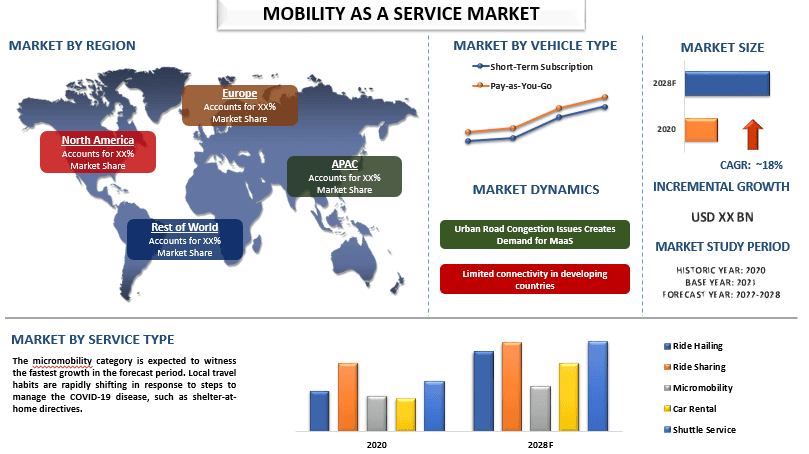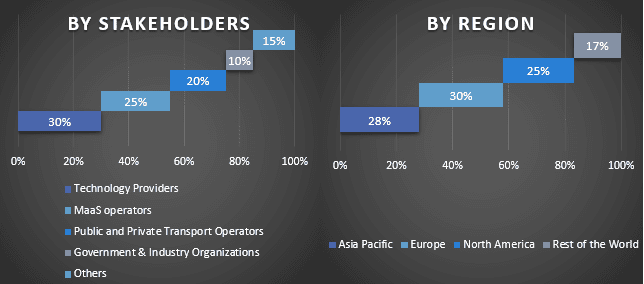- Home
- About Us
- Industry
- Services
- Reading
- Contact Us
Mobility-as-a-Service Market: Current Analysis and Forecast (2022-2028)
Emphasis on Service Type (Ride Hailing, Ride Sharing, Micromobility, Car Rental, and Shuttle Service); Vehicle Type (Two-Wheeler, Car, and Bus); Payment Mode (Short-Term Subscription and Pay-as-You-Go); Region/Country; Region/Country

Mobility as a Service (MaaS) is the integration of different transport services in one single digital mobility offer, with active mobility and an efficient public transport system as its basis. The Global Mobility as a Service Market is expected to witness a significant CAGR of around 18% during the forecast period owing to the rising urbanization and smart city initiatives coupled with increasing adoption of on-demand mobility services. Moreover, increasing focus reducing vehicles on the road, utilizing existing infrastructure for different economic scales, is further expected to drive the adoption of MaaS, globally.
Furthermore, Key players in the industry have been highly involved in partnerships and collaborations to meet the competitive edge in the market. For instance, in April 2022, Capitello Move and MaaS Global signed a strategic partnership to launch the world’s first eco-friendly mobility platform. Similarly, in June 2021, Grab, a mobility services provider, further enhanced the partnership with Hyundai to encourage utilization of MaaS and accelerate EV adoption, especially in Singapore, Indonesia, and Vietnam.
Some of the major players operating in the market include ANI Technologies Pvt. Ltd., Lyft Inc., Uber Technologies Inc., Beijing Xiaoju Technology Co. Ltd., Grab Holdings Inc., Hertz Global Holdings Inc., Avis Budget Group Inc., Enterprise Holdings Inc., Europcar Mobility Group S.A., and Sixt SE
Insights Presented in the Report
“Amongst vehicle type, car category held a majority share in the market”
Based on vehicle type, the mobility as a service market is divided into two-wheeler, car, and bus. In 2020, car category held a majority share in the market. Recently, online on-demand car-based services such as car-sharing, ride-sharing, and car rental are considered core products to attract car owners and offer a complete mobility solution. The market expansion can be mostly ascribed to technological developments that make it easier to access shared mobility services. In addition, the industry is expanding as a result of favorable government policies encouraging the implementation of carsharing programs, rising demand for affordable and practical mobility services, and other factors.
“Amongst payment mode, pay-as-you-go payment mode held a significant share in the market in 2020”
Based on payment mode, the mobility as a service market is divided into short-term subscription and pay-as-you-go. In 2020, pay-as-you-go payment mode held a significant share in the market. It offers individuals with stand-alone single mode fare and pricing structure and customer has to pay according to the distance covered from the beginning to destination. Some has evolved into loyalty-based incentives, with fare capped, demand led dynamic pricing such as Uber and Grab. Furthermore, growing adoption of on-demand mobility services, the penetration of smartphones coupled with rise and ease of doing digital payments is expected to drive the market for mobility as a service.
“APAC to hold a significant share in the market”
APAC to witness highest growth during the forecast period. The major factors driving the growth of the market include the increasing need for reducing air pollution and transportation cost, proliferating demand for efficient micromobility services for first- and last- mile connectivity, and declining battery price. The growth of the MaaS ecosystem has been exponential in the region, due to factors such as high availability, low pricing, and ease of functioning. The growth in adoption rate of Maas has been exponential recently. This is mainly due to the low-cost travel option offered under services such as micromobility service. Along with cost saving, micromobility can also save time of travel, due to its compact and swift nature.
Further, the growth of the industry is also attributed to growing working population and expanding middle-class population thus creating demand for new-age on-demand travel services. Moreover, major services providers in the market are continuously focusing on business expansion in order to attain a key position in the market…
Reasons to buy this report:
- The study includes market sizing and forecasting analysis validated by authenticated key industry experts.
- The report presents a quick review of overall industry performance at one glance.
- The report covers an in-depth analysis of prominent industry peers with a primary focus on key business financials, product portfolio, expansion strategies, and recent developments.
- Detailed examination of drivers, restraints, key trends, and opportunities prevailing in the industry.
- The study comprehensively covers the market across different segments.
- Deep dive regional level analysis of the industry.
Customization Options:
The global Mobility as a Service market can further be customized as per the requirement or any other market segment. Besides this, UMI understands that you may have your own business needs, hence feel free to connect with us to get a report that completely suits your requirements.
Table of Content
Research Methodology for the Mobility as a Service Market Analysis (2022-2028)
Analyzing the historical market, estimating the current market, and forecasting the future market of the global Mobility as a Service market were the three major steps undertaken to create and analyze the adoption of an Mobility as a Service in major regions globally. Exhaustive secondary research was conducted to collect the historical market numbers and estimate the current market size. Secondly, to validate these insights, numerous findings and assumptions were taken into consideration. Moreover, exhaustive primary interviews were also conducted, with industry experts across the value chain of the global Mobility as a Service market. Post assumption and validation of market numbers through primary interviews, we employed a top-down/bottom-up approach to forecasting the complete market size. Thereafter, market breakdown and data triangulation methods were adopted to estimate and analyze the market size of segments and sub-segments of the industry pertains to. Detailed methodology is explained below:
Seek More Details About Research Methodology
Analysis of Historical Market Size
Step 1: In-Depth Study of Secondary Sources:
Detail secondary study was conducted to obtain the historical market size of the Mobility as a Service market through company internal sources such as annual reports & financial statements, performance presentations, press releases, etc., and external sources including journals, news & articles, government publications, competitor publications, sector reports, third-party database, and other credible publications.
Step 2: Market Segmentation:
After obtaining the historical market size of the Mobility as a Service market, we conducted a detailed secondary analysis to gather historical market insights and share for different segments & sub-segments for major regions. Major segments are included in the report as service type, vehicle type, and payment mode. Further country-level analyses were conducted to evaluate the overall adoption of testing models in that region.
Step 3: Factor Analysis:
After acquiring the historical market size of different segments and sub-segments, we conducted a detailed factor analysis to estimate the current market size of the Mobility as a Service market. Further, we conducted factor analysis using dependent and independent variables such as various service type, vehicle type, and payment modes of Mobility as a Service. A thorough analysis was conducted for demand and supply-side scenarios considering top partnerships, mergers and acquisitions, business expansion, and product launches in the Mobility as a Service market sector across the globe.
Current Market Size Estimate & Forecast
Current Market Sizing: Based on actionable insights from the above 3 steps, we arrived at the current market size, key players in the global Mobility as a Service market, and market shares of the segments. All the required percentage shares split, and market breakdowns were determined using the above-mentioned secondary approach and were verified through primary interviews.
Estimation & Forecasting: For market estimation and forecast, weights were assigned to different factors including drivers & trends, restraints, and opportunities available for the stakeholders. After analyzing these factors, relevant forecasting techniques i.e., the top-down/bottom-up approach were applied to arrive at the market forecast for 2027 for different segments and sub-segments across the major markets globally. The research methodology adopted to estimate the market size encompasses:
- The industry’s market size, in terms of revenue (USD) and the adoption rate of the Mobility as a Service market across the major markets domestically
- All percentage shares, splits, and breakdowns of market segments and sub-segments
- Key players in the global Mobility as a Service market in terms of products offered. Also, the growth strategies adopted by these players to compete in the fast-growing market
Market Size and Share Validation
Primary Research: In-depth interviews were conducted with the Key Opinion Leaders (KOLs) including Top Level Executives (CXO/VPs, Sales Head, Marketing Head, Operational Head, Regional Head, Country Head, etc.) across major regions. Primary research findings were then summarized, and statistical analysis was performed to prove the stated hypothesis. Primary research input was consolidated with secondary findings, turning information into actionable insights.
Split of Primary Participants in Different Regions

Market Engineering
The data triangulation technique was employed to complete the overall market estimation and to arrive at precise statistical numbers for each segment and sub-segment of the global Mobility as a Service market. Data was split into several segments & sub-segments post studying various parameters and trends in the areas of service type, vehicle type, and payment mode in the global Mobility as a Service market.
The main objective of the Global Mobility as a Service Market Study
The current & future market trends of the global Mobility as a Service market were pinpointed in the study. Investors can gain strategic insights to base their discretion for investments on the qualitative and quantitative analysis performed in the study. Current and future market trends determined the overall attractiveness of the market at a regional level, providing a platform for the industrial participant to exploit the untapped market to benefit from a first-mover advantage. Other quantitative goals of the studies include:
- Analyze the current and forecast market size of the Mobility as a Service market in terms of value (USD). Also, analyze the current and forecast market size of different segments and sub-segments
- Segments in the study include areas of service type, vehicle type, and payment mode analysis of the regulatory framework for the Mobility as a Service industry.
- Analyze the value chain involved with the presence of various intermediaries, along with analyzing customer and competitor behaviors of the industry.
- Analyze the current and forecast market size of the Mobility as a Service market for the major region.
- Major countries of regions studied in the report include Asia Pacific, Europe, North America, and the Rest of the World.
- Company profiles of the Mobility as a Service market and the growth strategies adopted by the market players to sustain in the fast-growing market
- Deep dive regional level analysis of the industry
Related Reports
Customers who bought this item also bought










